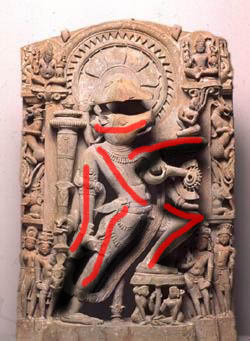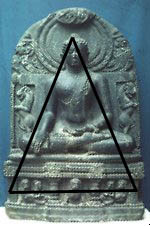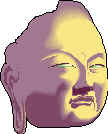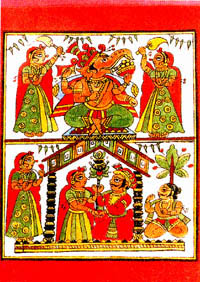|
Movement Activity The elementary teachers used this simple five-minute activity as a warm-up before working with the stories and before their Museum visit. Learning Outcomes: The student will use movement to adopt the pose and stance of a story character. Think of a story you have heard before where there is a hero and someone scary (a villain or demon of some sort). Think of the scariest part you can remember of this story! Show with your body and arms what it looks like when you are scared. What was your breathing like? Now think about the hero, and show with your body what it looks like to be brave and strong. What did you do with your head? Probably it was up. What did you do with your body? Probably it was extended in some way, and open, not folded up with your arms protecting you. What was your breathing like? Perhaps some of you thrust out your chest and took some big deep breaths! Let’s look at an image of a deity as a hero in India and see if you can take its
pose as well.
In this sculpture, the deity Visnu has taken the form of a boar to fight a demon. The sculpture shows him after he has killed the demon to save the world. Can you stand the way he is? Is this a pose you can easily hold for a long time? It shows that he is a brave hero, because his face is looking out and up, and his chest is thrust forward. He is not covering his chest, afraid that someone will strike him. His chest is full, as he has taken a big deep breath. FOUR-ARMED GANESA
Can you take this pose of Ganesa, with one hip out? Show what movement you think he would make next. How do you think he would dance?
Movement I Drawing I Drama I Storytelling Cloth
Don’t worry, although this is called a drawing activity, they are simple diagrams. Anyone can do this! Our project students were very successful in drawing a few simple lines while in the Museum gallery to diagram the movement and organization of the composition of these sculptures. Learning Outcomes: The student relates formal elements and compositional organization in an art object to the degree of movement perceived through the art: line, balance and symmetry. In the question and discussion section, we prompted students a number of times to determine whether a composition was static or active—that is, to describe the degree of movement. You recall the range of movement from Standing Visnu (static), to the Seated Buddha (primarily static, with a little movement in his hand touching the earth), to the Four-armed Ganesa (some movement in the curving forms of his arms, legs and trunk), to Varaha (active). By diagramming this movement with a few lines, this idea becomes concrete for students and enhances their interpretive and drawing skills. While it is great to do this in the Museum, it can easily be done from computer images or from the overhead projector as well. Begin with two examples like these to demonstrate the contrast between static and active. If you are using an overhead projector, put a blank transparency over the image and draw right on top of it so both are visible at once. Look how the triangle composition of the Seated Buddha creates a sense of stability and stillness; you can imagine him sitting that way for a long time. Next try Varaha, and draw a few lines to indicate the direction of his arms, legs, back and head. Quite a difference from Buddha! Ask the students to try one or two more on their own.
Movement I Drawing I Drama I Storytelling Cloth
As part of our project, third grade students gave simple performances based on several traditional stories from India. A few of these stories, Unity and In Search of the Elephant, are available to you here, rewritten for dramatic presentation with student narrators reading the text. Students taking the part of story characters work with movement to create a dramatic presentation of these stories. Learning Outcomes: The student replicates one of the artistic components of a dramatic performance. The student distinguishes between the main story line and story elaboration. The student recognizes a story as an effective means of teaching a way of living (moral). The stories are presented by having five students take turns as narrator, reading the text from the side. Students taking the part of characters do not speak lines, but use movement to act out the story told by the narrators. Holding a quick "post-play discussion" is a great way to reinforce and assess the learning outcomes. While preparing the performance, hold a class discussion to come up with two questions to ask the audience in addition to "What is the moral of the story?" After each story, have one student lead the discussion by asking their questions. We had an artist-in-residence who taught the students some Indian rhythms and dance steps that were incorporated into the performances. She also worked with some of the students to create visual art pieces using Indian design motifs that were employed as simple backdrops and props for the performance. You may wish to use a cassette tape of Indian music to set the scene. Movement I Drawing I Drama I Storytelling Cloth Another way that art tells stories in India is in storytelling cloths. There are several types of large painted cloths, used by itinerant storytellers, covered with paintings of the characters and illustrations of many episodes. Some storytellers hang their cloths in front of their audience and point out details as they speak. Often, there is a large-scale portrait of the main character in the center, surrounded by smaller illustrations showing the characters at different times.
The third- and sixth-grade students in our project both created their own storytelling cloths. We gave each student a piece of cloth approximately 1 1/2 x 2 feet to work on. For elementary students, using colored markers on butcher paper is a simple procedure. If you would like something more elaborate, try fabric paints on muslin. A less expensive alternative for paint is tempera paint on a length from a paper towel roll. Learning outcomes: The student identifies and defines Ganesa’s attributes found in images. The student creates symbols for a story in words and images to define character identity. The student recognizes the choices in story elements made by oral storytellers and visual artists. The student recognizes the use of individual image components (composition and scale) to represent the complex parts of a narrative whole. Begin by sharing another story of Ganesa, such as Why You Don’t Look at the Moon on Ganesa’s Holiday. Go through Ganesa’s attributes again and show an example of a storytelling cloth (like the one here). The painter chooses certain scenes to illustrate from a long story. Similarly, the storyteller will choose which episodes to include, leave out, or elaborate on for each telling, depending on how much time he has, how much he is being paid, and the interests of his audience. As an example, ask students to think back on the story Why You Don’t Look at the Moon and decide which three episodes they would choose to illustrate in a storytelling cloth. As students begin to work, remind them to use Ganesa’s attributes to identify him. Suggest that they think about how to use scale and placement to identify him as the main character. When time allows, it is wonderful to give students the opportunity to tell a story using their cloth. |








